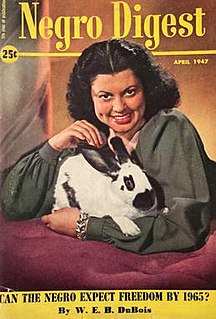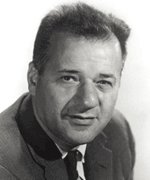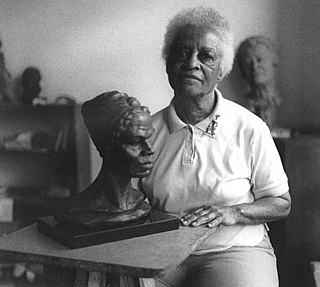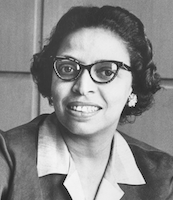Related Research Articles

Jeannette Theresa Dubois, known professionally as Ja'Net DuBois, Ja'net DuBois, and Ja'Net Du Bois, was an American actress and singer-songwriter. DuBois was best known for her portrayal of Willona Woods, the neighborhood gossip maven and a friend of the Evans family on the CBS sitcom Good Times, which originally aired from 1974 to 1979.

Charles Richard Johnson is a scholar and the author of novels, short stories, screen-and-teleplays, and essays, most often with a philosophical orientation. Johnson has directly addressed the issues of black life in America in novels such as Dreamer and Middle Passage. Johnson was born in 1948 in Evanston, Illinois, and spent most of his career at the University of Washington in Seattle.

The Black Arts Movement (BAM) was an African American-led art movement, active during the 1960s and 1970s. Through activism and art, BAM created new cultural institutions and conveyed a message of black pride.

John Harold Johnson was an American businessman and publisher. Johnson was the founder of the Johnson Publishing Company, headquartered in Chicago, Illinois. Johnson's Ebony (1945) and Jet (1951) magazines were among the most influential African-American businesses in media beginning in the second half of the twentieth century. In 1982, Johnson became the first African American to appear on the Forbes 400. In 1987, Johnson was named Black Enterprise Entrepreneur of the year.

Robert Hooks is an American actor, producer, and activist. He is most recognizable to the public for his more than 100 roles in films, television, and stage. Most famously, Hooks, along with Douglas Turner Ward and Gerald S. Krone, founded The Negro Ensemble Company. The Negro Ensemble Company is credited with the launch of the careers of many major black artists of all disciplines, while creating a body of performance literature over the last thirty years, providing the backbone of African-American theatrical classics. Additionally, Hooks is the sole founder of two significant black theatre companies: the D.C. Black Repertory Company, and New York's Group Theatre Workshop.

Jet is an American weekly digital magazine focusing on news, culture, and entertainment related to the African-American community. Founded in November 1951 by John H. Johnson of the Johnson Publishing Company in Chicago, Illinois, the magazine was billed as "The Weekly Negro News Magazine". Jet chronicled the civil rights movement from its earliest years, including the murder of Emmett Till, the Montgomery bus boycott, and the activities of civil rights leader Martin Luther King Jr.

Johnson Publishing Company, Inc. (JPC) was an American publishing company founded in November 1942 by African-American businessman John H. Johnson. It was headquartered in Chicago, Illinois. JPC was privately held and run by Johnson until his death in 2005. His publications "forever changed the popular representation of African Americans." The writing portrayed African Americans as they saw themselves and its photojournalism made history. Led by its flagship publication, Ebony, Johnson Publishing was at one time the largest African-American-owned publishing firm in the United States. JPC also published Jet, a weekly news magazine, from November 1951 until June 2014, when it became digital only. In the 1980s, the company branched into film and television.
While African-American book publishers have been active in the United States since the second decade of the 19th century, the 1960s and 1970s saw a proliferation of publishing activity, with the establishment of many new publishing houses, an increase in the number of titles published, and significant growth in the number of African-American bookstores. African-American commercial book publishers released a total of 154 titles in the period 1970–74, a dramatic rise from the previous high of 21 titles published during the five-year spans of 1935–39 and 1940–44. Institutional and religious publishers also increased their title output, rising from 51 titles in the years 1960–64 to 240 titles in 1970–74. Concomitantly, there was a widening in the scope of publishing objectives on the part of African-American book publishers, who began to release titles that not only advanced their particular ideologies but dealt with topics unrelated to Black Americana or Africana. Such diversity is emblematic of the increasingly important role in American culture and society of African-American book publishers.
Virginia Portia Royall Inness-Brown (1901–1990) was a proponent of the arts and first recipient of the Handel Medallion of New York City, in 1959.

The Negro Digest, later renamed Black World, was a magazine for the African-American market. Founded in November 1942 by publisher John H. Johnson of Johnson Publishing Company, Negro Digest was first published locally in Chicago, Illinois. The magazine was similar to the Reader's Digest but aimed to cover positive stories about the African-American community. The Negro Digest ceased publication in 1951 but returned in 1961. In 1970, Negro Digest was renamed Black World and continued to appear until April 1976.
The American Negro Academy (ANA), founded in Washington, DC in 1897, was the first organization in the United States to support African-American academic scholarship. It operated until 1928, and encouraged African Americans to undertake classical academic studies and liberal arts.
The Organization of Black American Culture (OBA-C) was conceived during the era of the Civil Rights Movement by Hoyt W. Fuller as a collective of African-American writers, artists, historians, educators, intellectuals, community activists, and others. The group was originally known as Committee for the Arts (CFA) which formed in February 1967 on the Southside Chicago. By May 1967 the group became OBAC and included Black intellectuals Hoyt W. Fuller, the poet Conrad Kent Rivers, and Gerald McWorter, OBAC aimed to coordinate artistic support in the struggle for freedom, justice and equality of opportunity for African Americans. The organization had workshops for visual arts, drama, and writing, and produced two publications: a newsletter, Cumbaya, and the magazine Nommo.

Ben Burns was an American pioneering editor of black publications and a public relations executive in Chicago. He was a “top executive editor” for the Johnson Publishing Company who became so well known as a “black newspaperman” – even though he was white and Jewish – that he was invited to submit his biography for inclusion in Who's Who in Colored America.

Ruth Inge Hardison was an American sculptor, artist, and photographer, known particularly for her 1960s busts entitled "Negro Giants in History". Her 1983 collection called "Our Folks", which features sculpted portraits of everyday people, is also of note. Hardison's artistic productions largely surround historical black portraiture, and she is especially interested in creatively representing the unspoken voices of the African American past. She was the only female in the Black Academy of Arts and Letters (BAAL), a group that encourages awareness of black artistic accomplishments, when this organization was founded in 1969.

Doris E. Saunders was an American librarian, author, editor, businesswoman, and professor of Journalism. She started her career as Johnson Publishing Company librarian and then became head of the Johnson Publishing Company Books Division. Later in life, Saunders founded Ancestor Hunting, a genealogy research company, and wrote its publication, "Kith and Kin: Focus on Families." She was also Professor of Journalism and Chairwoman of the Department of Mass Communication at Jackson State University. After her retirement from Jackson State, Saunders continued to work with the Books Division at Johnson Publishing.
Mojo was a newspaper based in Harlem, New York City. The first issue was published in 1968. Poet Julian Ellison, was editor of Mojo. As a new and independent publication, Mojo was "an organ of the Black Student Congress".
The Black Theatre Alliance (BTA) was a federation of African American theater companies in New York City that was founded in 1971 by playwrights Delano Stewart, Hazel Bryant, and Roger Furman. Duane Jones was executive director from 1976 to 1981. The organization sought to provide institutional support and resources to independent artists and touring companies. As one of seven subcontractors for the Cultural Council Foundation CETA Artist Project, which ran from 1978 to 1980, the Alliance was able to hire 35 actors, directors and playwrights, and mount performances throughout the city. The BTA had a national membership of over sixty black theater and dance companies before being reported as defunct in 1984.
Addison Gayle, Jr. was an American professor, literary critic, and author in New York City. He advocated for a Black aesthetic.
Brown is a Beautiful Color is a picture book written by Jean Carey Bond and illustrated by Barbara Zuber. The book was first published by Franklin Watts in 1969.
JoAnna LaSane, also written as Joanna Lasane, was an American model and arts administrator. She served on the New Jersey State Council of the Arts, and was director of the Atlantic City Children's Theatre. In 1996 she was inducted into the Atlantic City Women's Hall of Fame.
References
- 1 2 Black World/Negro Digest. Johnson Publishing Company. May 1969. p. 50.
- ↑ Black World/Negro Digest. Johnson Publishing Company. May 1969. pp. 50, 89.